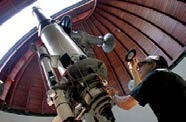STEM Careers: Astronomer & Astrophysicist

When you look at Earth from the vast reaches of space, it looks like a blue marble. In the words of Carl Sagan, from his book, Pale Blue Dot, "That's here. That's home. That's us. On it everyone you love, everyone you know, everyone you ever heard of, every human being who ever was, lived out their lives." Do you ever look up at the night sky and wonder what happens beyond the confines of this planet?
Astronomers and astrophysicists study the origins of the universe, galaxies and stars. They use modern technology to observe the billions of galaxies beyond the Milky Way, and use this data to find new stars. Theoretical astronomers use advanced mathematics to mold theories surrounding the laws of the universe. Some of these theories, such as Albert Einstein's Theory of General Relativity, end up impacting our lives in very real ways. Theoretical astronomers will usually find work in academia and will conduct research in their office; experimental astronomers and astrophysicists can find work in academia as well, but may also work for the government, such as at the National Aeronautics and Space Administration (NASA), or for private research institutions. Some astronomers have to work non-traditional hours, because many will go to observatories at night to study the sky in more complete detail.
Students considering astronomy and astrophysics should begin by taking physics and calculus in high school. Many colleges and universities offer undergraduate degrees in physics, astrophysics and astronomy. To do independent research, a doctorate in one of these fields is also required.
Astronomers and astrophysicists can expect to see job growth in the future: it is expected that the demand for astronomers will grow by 11 percent from 2010 to 2020. Astronomers, on average, earn $87,260 a year, according to the Bureau of Labor Statistics, though the pay varies widely.